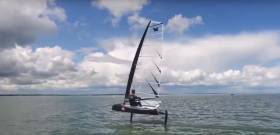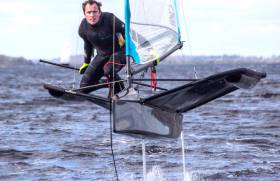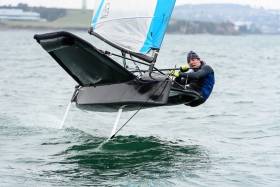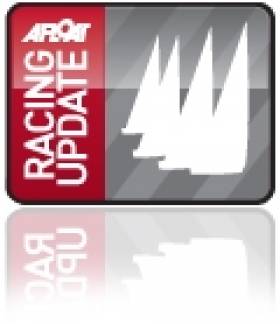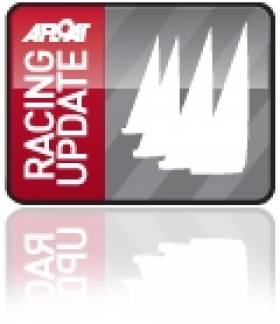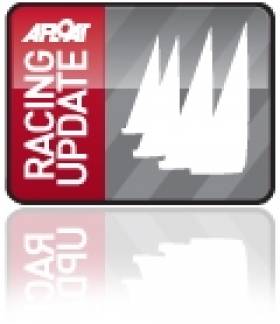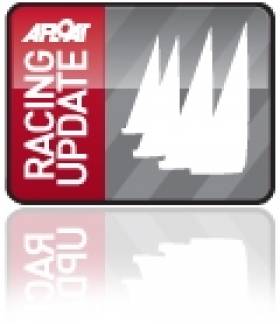Displaying items by tag: moth
Fitzpatrick Wins Howth Yacht Club Moth Flutter (Video)
Rory Fitzpatrick sailing Little Drinkie was the clear winner of the Howth Yacht Club 10–boat Moth flutter beating Alistair Kissane sailing Enzo by 5 points. The full results are downloadable below.
With nine wins in ten races, Rory Fitzpatrick of the National Yacht Club is the undisputed king of the Irish Moth Tour 2016 following the weekend's Moth Inland Championships held on the inner lakes of Lough Ree.
Although Fitzpatrick, who finished on eight points after two discards, showed a clean pair of heels to the rest of the nine–boat fleet, Royal Cork's David Kenefick did well to take second on 21 points from Rio selected Annalise Murphy who finished five points behind in third overall.

Winner Rory Fitzpatrick in flying form on Lough Ree and below Annalise Murphy, both of the National Yacht Club. Photos: Courtesy Con Murphy
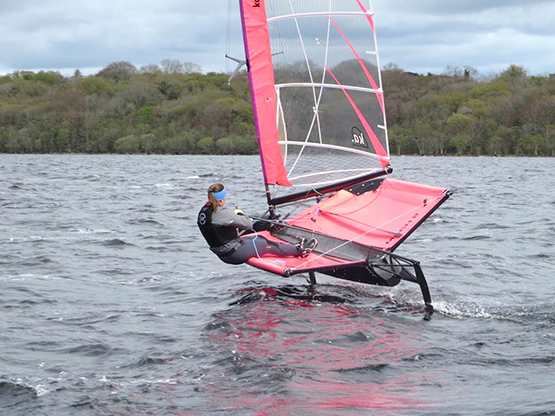
Full results are downloadable below.
The event was staged at the Wineport lodge hotel and the Moths were joined on the course by a ten boat Water Wag fleet (below) that featured a coaching session from UK sailing coach Mark Rhodes.

Kenefick Moves to Moth Dinghy at Royal Cork
Former Figaro keelboat campaigner David Kenefick from Royal Cork Yacht Club is back on the water (or is that above the water?) in Cork Harbour. Kenefick is the latest sailor to move to the foiling Moth dinghy that is centred at the National Yacht Club in Dun Laoghaire.
#Speed - As British sailor Hannah White launches her bid to become the fastest woman on water, could the likes of Ireland's Olympic hero Annalise Murphy be inspired to make their own record-breaking attempts?
Yachting Monthly reports on sailor and broadcaster White's plans not only to break the women's speed record over one nautical mile with the purpose-built Moth foil Speedbird, but also reach a speed above 40 knots.
Doing so will involve a combination of state-of-the-art boat design, with titanium and carbon fibre components, and peak physical conditioning on the part of White – who is already training with a cross-discipline team to build new muscle groups for the core strength needed.
That's a challenge indeed, but nothing insurmountable for this experienced endurance sailor, who only this week became the fastest person to cross the English Channel by single-handed dinghy.
The question is, does Ireland have the calibre of high-performance sailors to attempt such a feat?
Annalise Murphy would make an excellent candidate – she might be focused on next summer's Olympics right now, but she's building up experience in the Moth, and would be well placed to launch her own speed record bid after the Games.
What other Irish sailors could take on the record? Have your say in the comments below!
Annalise Murphy Finishes Second Lady At Moth Worlds
#MothWorlds15 – Kiwi sailing sensation Peter Burling dominated the 2015 Moth Worlds in Sorrento, Australia last Friday but two Irish sailors featured in the top class field too. The National YC's Annalise Murphy finished in 56th place and Howth's Alistair Kissane finished in 58th place from 158 entries
In the very heavy winds of the last race Olympic Radial champ Annalise scored 30th, putting her second lady overall. She told Afloat.ie:
'My gantry exploded when I was in eighth coming down the last downwind to the finish. Managed to grab my rudder before it sank. I'm ok, just annoyed, it would have been an epic way to finish! I am seriously battered though!
Emirates Team New Zealand sailor Peter Burling won the following his domination of the event with 9 race wins in the 14 race series. "There are some great guys in this record fleet, I am absolutely stoked to win," said World 49er Champion Burling who will have little time to celebrate and is then heading to the ISAF Sailing World Cup in Miami, then it's back to America's Cup duties.
The Irish results were made all the more significant taking account of the quality of entries at the event in Sorrento Sailing Couta Boat Club – including five members of the Americas Cup winning Oracle USA team, sailors from the Artemis and Emirates teams, world champions and Olympic gold medalists including Tom Slingsby who sailed with John Bertrand to win the Etchells Worlds in Howth in 2010.
Kissane managed a very steady set of results including 26th and 20th place in the final two races. According to the Howth Yacht Club website, Kissane spent six hours repairing his Moth before the final day – a product of racing these foiling boats in the high wind and sea conditions that were prevalent in the latter part of the championships.
Pitch Poles & Survival For Annalise Murphy As Moth Worlds Breezes Up in Port Prince, Australia
#mothworlds – Race officials were forced to abandon racing on day four of the McDougall + McConaghy 2015 International Moth World Championship being hosted by the Sorrento Sailing Couta Boat Club (SSCBC) at Sorrento in Victoria because of strond winds at the venue, the first stong winds the worlds fleet has had since Lake Garda, three years ago.
At a meeting with Moth competitors this morning, Event Director, Peter Osbourne (from the SSCBC) asked for a show of hands for racing. Most in the Gold fleet elected for racing. All but a couple in the Silver fleet voted against.
Officials asked competitors to stay ashore while they waited for visibility to improve, along with the general conditions, including pouring rain and blustery conditions.
Day 2 also brought about some strong winds and action packed racing. Ireland's Annalise Murphy features in the above vid.
#mothsailing – The National Yacht Club's Annalise Murphy and Howth Yacht Club's Alistair Kissane qualified for the Gold Fleet of the 2015 foiling Moth World Championships in Sorrento, Australia.
Consistent results on the second day of the regatta meant that both Murphy in 62nd place and Kissane in 70th are through but unfortunately Bangor's Olympian Ryan Seaton just missed the cut, qualifying for Silver Fleet in 82nd place.
As Afloat.ie reported earlier, the Irish crews are in celebrated company, with leaders including America's Cup syndicate campaigners such as Emirates Team New Zealand's Pete Burling, and Artemis Racing's Nathan Outerridge as well as other notables such as Tom Slingsby, Iain Jensen, Scott Babbage, Dean Barker and Ray Davies.
Speaking to reporters, Irish Olympic Radial sailor Murphy, said after day two:
"It was stressful conditions, pretty wavy on the downwinds and I also learnt how to pitch-pole less; in the first race I pitch-poled five times, in the second race only twice, in the third race only once and in the last race I didn't pitch-pole at all, so I was getting better each race with not trying to kill myself on the downwind. Stressful but a lot of fun!"
The top 79 of the 153 sailors make the 'cut' for the Gold Fleet following the second day of racing at Sorrento Sailing Couta Boat Club in Victoria.
New Zealand's Peter Burling reeled off four straight wins to take the lead on the 2nd day, sounding the warning bell for the other 159 competitors. With the fleet split into Blue and Yellow, Burling was in the Blue fleet on a course closer to shore. Defending world champion Nathan Outteridge (AUS) was in the Yellow on a course further out and on the receiving end of bumpier conditions and scored 3-2-2-1 results.
Ashore Burling said: "I won all four races – the last one by over a lap, which is pretty pleasing in this fleet. it's all come together here," he said referring to his disappointing results at the Worlds in 2011 and 2013. I did well in the light and shifty weather yesterday and today was as good. I put a lot of work into improving my game for this event. We were in flatter more manageable water than the Yellow fleet, but even so, I dropped off the foil at one stage and fell back to 11th, but I still got back and won. Everyone had a swim, or crashed or overtook," the 2012 Olympic 49er silver medallist said of the course, which was closer to the Sorrento Sailing Couta Boat Club, host for the event.
On Nathan Outteridge, Burling said: "Both of us have different commitments now – me with Emirates Team NZ and him with Artemis Racing (AC syndicates). We're still good mates, but things are slightly different now. He is my biggest challenge for this title, of course."
Full details here
#mothworlds – Three Irish sailors are among 165 set for tomorrow's McDougall + McConaghy 2015 International Moth World Championship to be sailed in Sorrento, Australia from 9-16 January, 2015, on Port Phillip. The fleet are chomping at the bit for some foiling action but like yesterday there is no racing at the Moth Australian Nationals, a pre–cursor to tomorrow's worlds.
As Afloat reported last month, Howth Yacht Club's Alistair Kissane, Bangor's Ryan Seaton and the National Yacht Club's Annalise Murphy have made the journey for the foiling championships.
Among the top entries is defending world champion Nathan Outteridge. The NSW 2012 Olympic 49er gold medallist and America's Cup skipper for Artemis Racing will attempt to defend his title and in the process become one of the first world champions in the New Year.
Outteridge is well aware those he will race against are just as credentialed. Concentrating on his 2016 Olympic 49er campaign in Rio and the Worlds in Santander, he has also been flat out in his role as skipper for Artemis Racing in San Francisco these last few months.
"I actually haven't sailed my Moth at all since the 2014 Worlds in Hayling Island back in July," said the multi-skilled sailor.
More here
Irish Sailors Prepare To Race at 2015 Moth Worlds
#moth – Three Irish dinghy sailors will join America's Cup stars, Olympic medallists and world champions among a record 150 plus sailors converging on Port Phillip, Australia next week when the Sorrento Sailing Couta Boat Club (SSCBC) in Victoria hosts the McDougall + McConaghy 2015 Moth World Championship from 9-16 January, 2015.
Howth Yacht Club's Alistair Kissane, Bangor's Ryan Seaton and the National Yacht Club's Annalise Murphy are all making the journey for the foiling championships.
Earlier this year, Murphy won the Moth Ladies World title when the event was staged in Hayling Island in the UK.
Defending Moth world champion and Artemis America's Cup helm, Nathan Outteridge (AUS), heads the line-up. Like so many others, Outteridge, the 2012 Olympic 49er gold medallist, will take on fellow crew and rivals from the Olympics and the America's Cup, among them his 49er medallist crew and fellow Artemis member, Iain 'Goobs' Jensen.
Other Artemis entries are Loick Peyron (FRA), who has four ORMA titles and a Transat win among his illustrious results, and 2008 Beijing Laser gold medallist Paul Goodison (GBR).
Intermingled with other big names are winning Oracle Team members Tom Slingsby (AUS), Philippe Presti (FRA), Rome Kirby (USA) and Joey Newton (AUS), while Emirates Team New Zealand boats Glenn Ashby (AUS) and Kiwis Dean Barker, Ray Davies, and Peter Burling and Blair Tuke, the 2012 Olympic 49er silver medallists.
Burling and Tuke are Outteridge and Jensen's rivals, and not just in the 49er, according to Tom Slingsby, who slates Burling as the biggest potential threat for the Moth world title.
"Peter Burling is the man to beat. I've been watching him, he's sailing really well and improving all the time," says Slingsby, the first Australian to be named ISAF World Sailor of the Year (2010) and Oracle strategist.
Slingsby is running himself ragged in the lead-up. Competing in the Moth class at Sail Sydney along with other Moth Worlds candidates, on Tuesday he will call tactics aboard Perpetual Loyal in the SOLAS Big Boat Challenge on Sydney Harbour and in the Rolex Sydney Hobart. In between, the 30 year-old will skipper Oman Air in the Extreme Sailing Series from 11-14 December, but insists he is enjoying every minute.
"I had a break from sailing – I needed it. But now I'm enjoying all the opportunities that are coming my way," said Slingsby, a multiple world title holder in the Olympic Laser class and former Etchells world champion. "The Extreme is a great opportunity to sail with some of my Oracle crew and it will give me time on the water and practice for the Moth Worlds," he said.
"Realistically, there are 10-15 people who could win the Worlds. People are coming up with new twists all the time. The Moth is developing all the time, as can be seen with the foiling," explains the Terrigal sailor who with his Oracle team mates has been practicing on the home turf of Outteridge and Jensen at Wangi Wangi on the NSW Central Coast.
"I'm more local than they are now," he says laughing. "The Oracle guys have spent a bit of time there because the conditions are perfect for Moth sailing – it's quiet – there are no distractions, so we can concentrate on sailing."
Tornado Olympic medallist Glenn Ashby owns more world championship trophies across a broad range of multihull classes than anyone else. Leaving the woes of losing the America's Cup behind him, the Bendigo sailor commented: "it will be, without doubt, the single most high-performance regatta I've ever done.
"There'll be at least eight Olympic medallists, three Moth world champions and 15 America's Cup sailors," added sailmaker Ashby, who is already in Sorrento practicing regularly with Emirates Team NZ crew.
Bora Gulari, the 2013 Moth world champion returns this year after taking a year off. Since his win in Hawaii, the American has been training with the Luna Rossa America's Cup syndicate.
Missing in action will be America's Cup winning skipper, Jimmy Spithill, who is having his elbow operated on, but another Spithill will take his place. Younger brother Tom will try his luck in this fast-paced high-level foiling class and has also been putting in practice.
In the younger set too is 2012 Moth world champion, Josh McKnight (AUS), who has to be considered a threat after winning the title at his first Worlds. He was also crowned the 2013 NSW Moth title and in July, won the Open Italian Moth Championship.
Women have thrown their hats in the 'Moth sphere' too, notably local sailor, Sam England. The 2011 Moth Worlds Women's winner is training hard to bring the trophy home again. Multi-skilled Wakako Tabata, 470 Women's Japanese representative at the 2012 Olympics, also competes in the Laser Radial and Mixed Nacra 17, while Annalise Murphy (IRE) finished fourth at the 2012 Olympics in the Laser Radial.
A huge thanks to @EtihadAirways for getting me and my boat all checked in and on our way to Melbourne for @mothworlds pic.twitter.com/84W9B8s13J
— Annalise Murphy (@Annalise_Murphy) December 26, 2014Japan, Great Britain, Denmark, Italy, Switzerland, USA, South Africa, New Zealand, Austria, Hong Kong, France, Ireland, Sweden and Australia are all well represented.
It is not the first time that SSCBC, located in the pretty seaside holiday destination of Sorrento, has hosted a major event; numerous competitors are familiar with the waters having contested the 49er Worlds here in 2008.
"The Sorrento Sailing Couta Boat Club enjoys a first-class reputation for managing and running major sailing events," Andrew Plympton, SSCBC's Commodore commented. "And we're looking forward to welcoming everyone here. Already Glenn Ashby and others from Emirates Team New Zealand are training here," he said.
"The McDougall + McConaghy Moth Worlds will be the centre of attention during our typically busy January period and 10 days of sea breeze, sunshine and flat seas have been ordered.
"Planning with the Moth Association and our club started some two years ago," he said of the event organised by SSCBC in conjunction with the International Moth Class Association.
Co-sponsor of the Moth Worlds, McConaghy's Jono Morris said: "McConaghy Boats has had an enduring association with the Moth class. As foiling started to become the norm for the fleet, we started to work with Andrew McDougall on the Bladerider project when we set up in China in 2006. Between 2006 and 2008, we built around 300 Bladeriders together.
"In 2008 we launched the Mach2, which took everything we had learned collectively from the Bladerider and improved it in every respect. Today, we've built over 500 Mach 2's, combined with 300 Bladeriders; that's 800 hydrofoiling moths and counting," he said.
McDougall is also a stalwart sailor of the class and will have his work cut out taking on the younger guns in the fleet. "I'm realistic. A top ten finish would make me proud. I no longer have a serious speed advantage over the fleet, because they've got the gear I developed, so it's a more even playing field now."
Spectators can catch a glimpse of what is to come when the SSCBC hosts a round of the Victorian Moth Grand Prix sponsored by KA Sails this weekend and the McDougall + McConaghy Moth Australian Championship ahead of the Worlds from 6-8 January. Those keen to go on the water to view the Worlds can register their interest with Sorrento Sailing Couta Boat Club.
Annalise Murphy Moth Foiling Off Dun Laoghaire
#mothsailing – Irish sailing superstar Annalise Murphy was Moth sailing at the weekend, participating in the latest round of the Irish Moth circuit at the National Yacht Club in Dun Laoghaire. A combination of high speed video action from a chasing RIB plus and onboard shots shows how the Laser ace also had the skills to win the Women's World Moth champs at Hayling Island in the UK in August.




























